Our research, including this set of findings conducted in partnership with the Gates Foundation, includes an annual survey of collaborative funds and vehicles (2021-2024) and targeted publications to support donors considering giving collaboratively—in general, and on particular topics such as the Global South, gender equity, racial equity, and democracy. Our research has also focused on supporting collaborative leaders as they hone their measurement and learning, on key trends informing the collaborative philanthropy field, and on questions collaborative leaders ask as they launch and significantly update their work.
While we have engaged with dozens of donors on their experiences working with collaboratives, this is the first time we have formally surveyed them on the topic.1 The goal was to understand funders’ experiences giving in this way, to clarify how they engage in this approach, and to elicit their perceptions of opportunities and barriers to engaging with collaboratives.
Who responded?
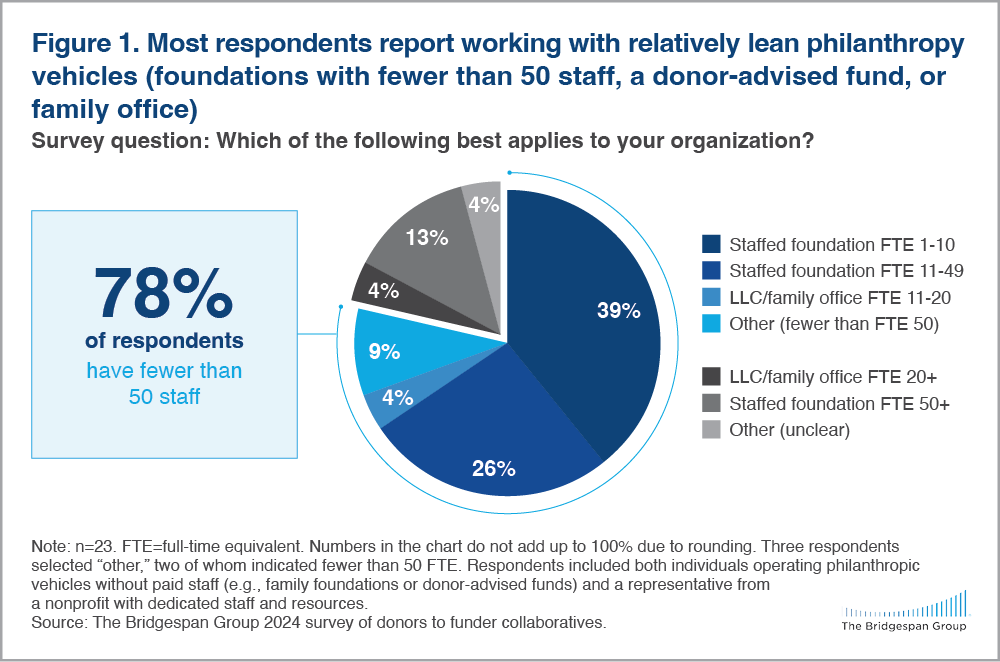
The Gates Foundation shared the survey with 46 funders who actively give to collaborative giving vehicles, and we invited a handful of others to respond, in the fall of 2024. We received 23 complete responses—a strong response rate, though, to be sure, still a small sample. The survey itself had 25 questions and allowed for written responses, which helped us understand the nuances.
Most respondents utilize lean approaches to their philanthropy, making them the type of funders for whom we believe collaborative giving offers a clear value proposition. Most respondents also play a significant leadership role with collaboratives, reflecting a high level of expertise. For example, nearly 70 percent helped to found one or more collaboratives, and nearly half have a formal decision-making role on at least one collaborative board.
Why do donors give to collaboratives, and how do collaboratives fit into a donor’s portfolio?
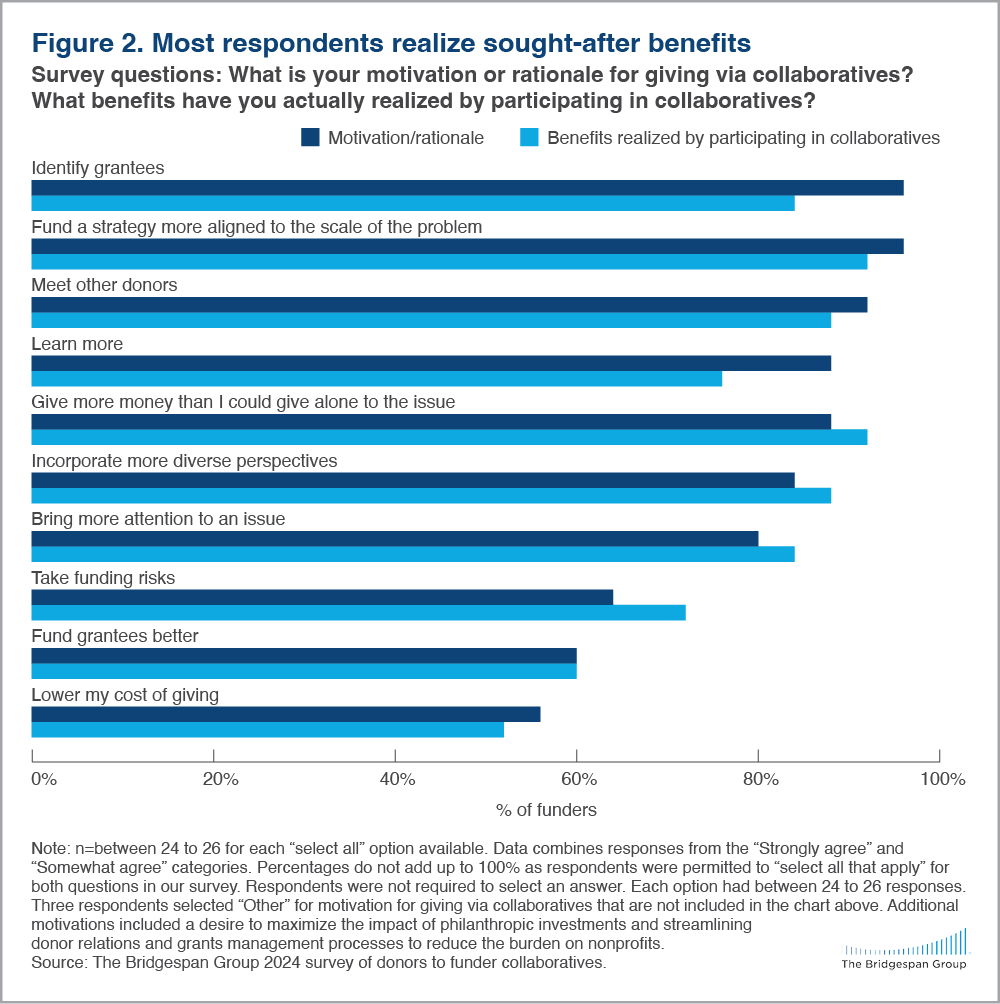
We asked donors what motivates their participation in collaborative giving and whether they realized those benefits. Over 80 percent of donors reported being satisfied that the collaboratives they fund meet or exceed their overall expectations.
Nearly all respondents give to collaboratives for reasons associated with doing more than they could alone. This aligns with prior Bridgespan research, which found donors often collaborate to give more efficiently and effectively, while engaging with other peer donors and practitioners.
Efficiency includes enabling donors to find grantees they couldn’t alone, to give more than they can give alone, or to lower their cost of giving. Effectiveness includes funding a strategy more aligned to the scale of issues they are addressing, incorporating different perspectives, bringing attention to an issue, and funding grantees better. And engagement refers to meeting like-minded donors and learning while giving alongside peers.
Of course, there are always trade-offs. “In some ways my expectations were exceeded,” wrote one donor. “But the speed of collective decision making feels slower and the reorientation to our shared agenda each time new people join slows the process down. I’ve had to lower my expectations on how quickly we can move on things.”
Interestingly, reducing risk and lowering costs sat toward the bottom of sought-after benefits.
How are donors finding and evaluating funds?
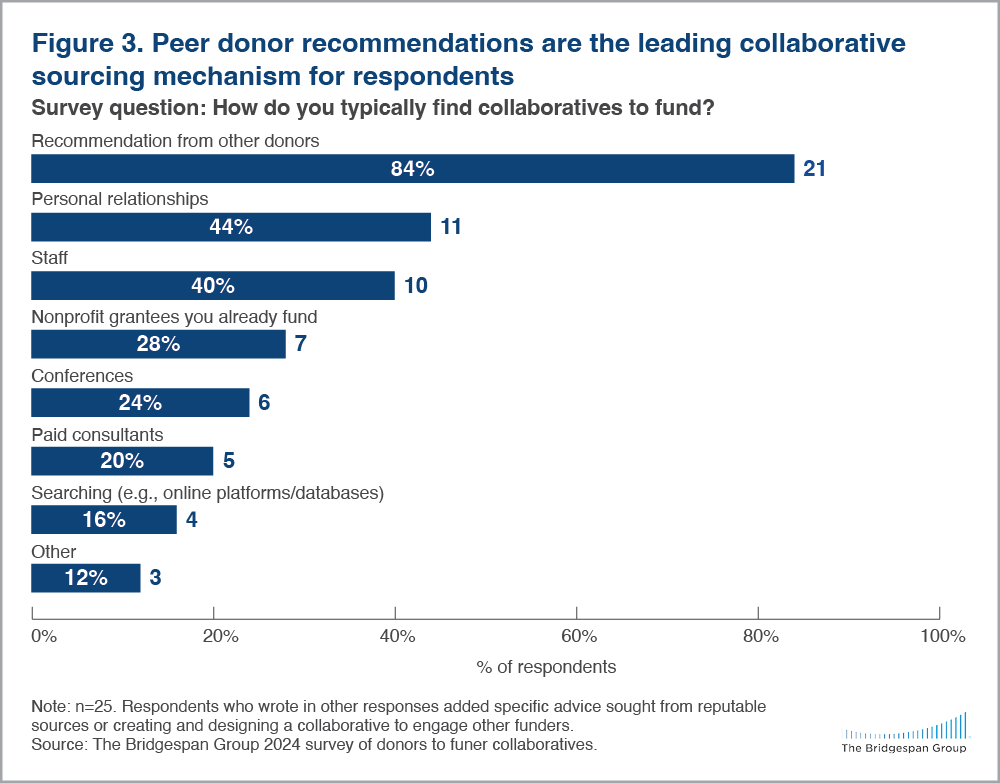
Almost all respondents reported finding collaboratives through relationships—most commonly via recommendations from other donors. Others find collaboratives through personal relationships, staff, existing nonprofit grantees, and conferences. This raises important questions around the role that donors can play in growing this marketplace, as well as the need for more formal sourcing and matching mechanisms. For the collaborative market to become a more formal “asset class,” it’s likely that formalizing sourcing and matching mechanisms would enable less reliance on informal relationships—ultimately broadening access and insight for a wider range of donors. In the near term, this points to the critical role donors can play in growing this marketplace.
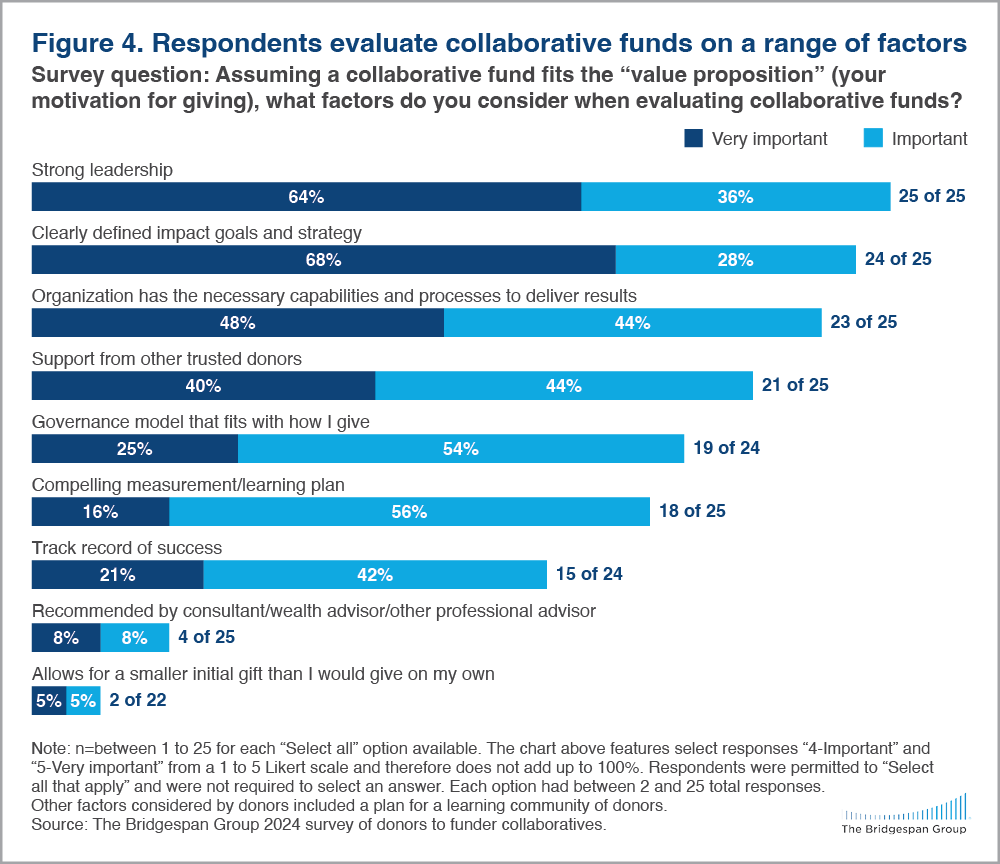
Unsurprisingly, most of the factors donors use to evaluate collaboratives are not so different from how they evaluate any potential grantee: for example, evaluating leadership, impact goals, and track record. The areas that are more particular to collaboratives are around governance and support from other trusted donors.
What role do collaboratives play in donors’ giving portfolios?
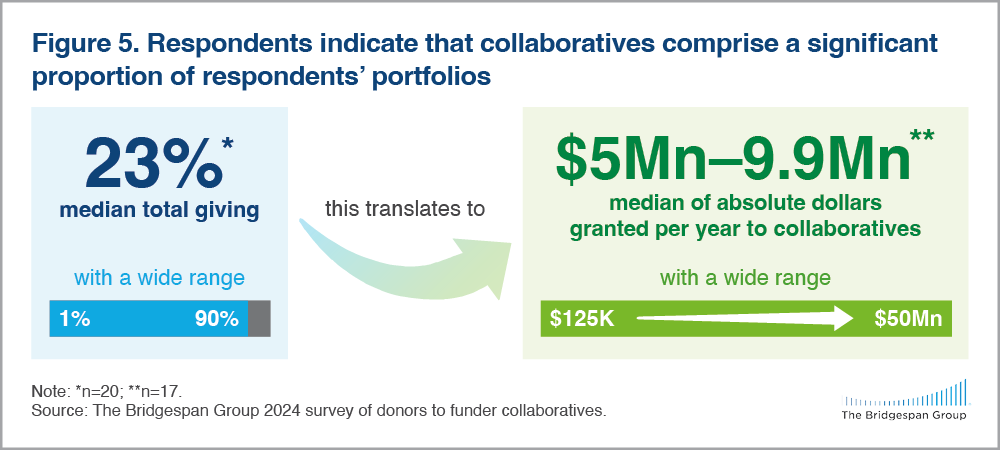
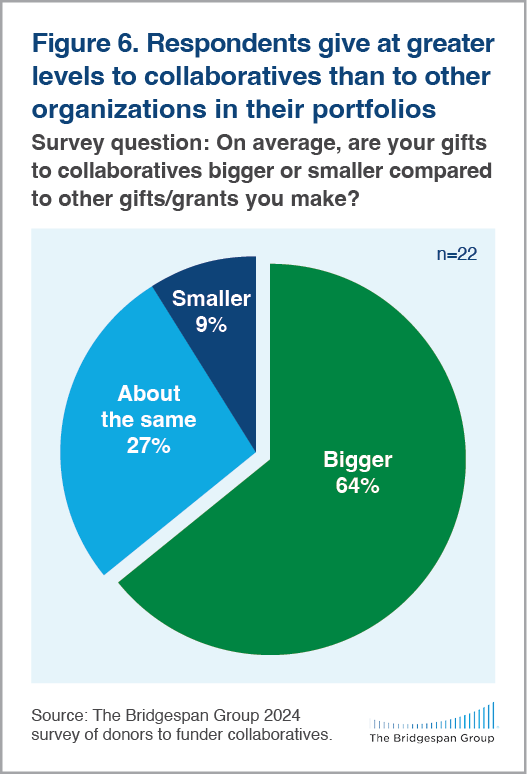
In a finding that was both surprising and encouraging, collaboratives are not only meeting and exceeding most expectations but also playing a meaningful role in the portfolios of the donors who responded.
What’s more, when these funders give through collaboratives, they give in larger amounts than other grants they make. Over one-third reported contributing more than $10 million to any one collaborative, which is significantly more than the median grant size ($100,000) for larger, staffed foundations in the Center for Effective Philanthropy’s extensive database of nonprofit survey respondents.2
What are donors funding?
Even with this small sample size, donors mentioned over 25 topic areas they fund via collaboratives, with some of the most common being climate change, environment/energy, and economic mobility/development. The high percentage of climate funding comes as no surprise—we’ve seen an increase of climate-focused funds in the past few years.
A movement-building focus is prominent with this set of funders, with over 80 percent funding the approach. Nearly half focus on place-based giving and disaster relief. Nearly half are also funding in a complex issue area toward a major milestone—elimination of neglected diseases, for instance.
Over 80 percent of the donors we surveyed are funding in North America, and over half fund in Africa. The North American focus is likely influenced by the disproportionately North American respondent sample set. Other geographies funded by over a third of respondents were Asia and South America, with few respondents funding in the Pacific and Caribbean regions.
Most respondents have made contributions to collaboratives in the form of general operating support, and nearly half have given money expressly for collaborative operations and/or capacity building. When asked what prompted the allocation of funding to operations, most donors cited the importance of the collaboratives’ sustainability and ability to ensure quality execution. “There is no way to professionally deliver on collaboratives without high-quality operations, [which] is often under-resourced,” wrote one donor.
With upwards of 500 collaborative vehicles in existence (over 300 of which are searchable in this database), one donor cautioned not to reinvent the wheel: “Ensure that you have fully assessed the landscape and that a new collaborative is truly needed and is not duplicative.”
How are donors approaching governance?
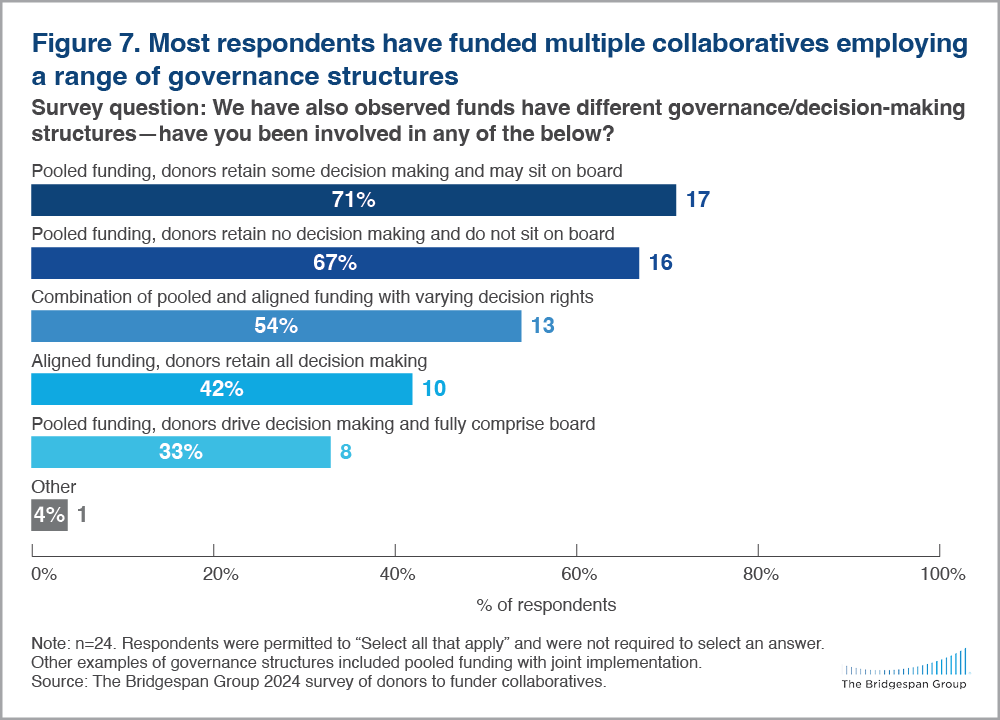
Most respondents participate in multiple collaboratives—with a broad array of participation styles. For example, nearly as many respondents are part of organizations that pool funds with no decision or board rights as are part of pooled funds that offer decision rights and possible board seats.
Some donors prefer to defer decisions to staff and consider this a part of funding collaboratively, trusting collaboratives’ leadership and their teams. “We try to choose collaboratives that are already somewhat aligned with our issues or approach,” wrote one donor. “Then we expect to let go of some amount of control over the process.”
But others prefer a structure that allows for choices to be made separately. “For the collaboratives through which we’ve given the most money, each [donor] participant decides who to fund and how much based on their own giving priorities and budgets,” wrote another donor.
Donors noted that their expectations for governance differ for collaboratives with different structures and goals, and at different stages of development. More clarity on common governance and decision-making approaches could provide more structure for the field to grow.
When launching a new collaborative, respondents emphasized the importance of aligning early on a governance structure and working with other funders to set terms, objectives, and goals from the outset. “When starting [a new collaborative], hear everyone’s concerns, then craft a governance structure and terms that best align with ‘deal-breaker’ requirements and ‘nice to haves,’ as much as possible,” wrote one donor.
What barriers prevent donors from giving more via collaboratives?
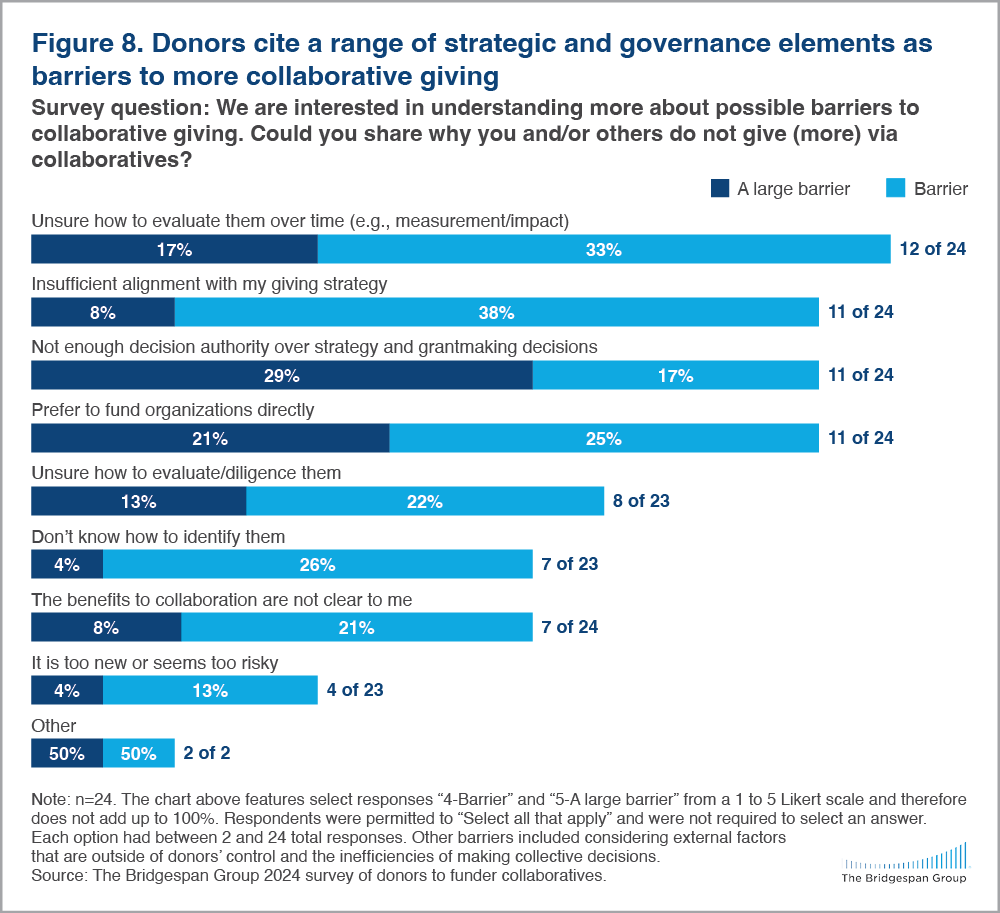
This group of funders had diverse concerns that held them back from giving more through collaboratives—no single barrier was cited by more than half of the respondents. Some barriers touched on preferences that relate to the entire idea of giving collaboratively (or the overall “asset class”)—such as preferring to fund organizations directly or a lack of familiarity with the benefits. Others included how they can find collaboratives and evaluate them over time, noting the possibility for more tools to support sourcing and evaluation. Finally, some barriers were more about the fit of any particular collaborative with a donor’s strategy (i.e., insufficient strategic alignment or decision-making authority).
Collaboratives are one of many ways to expand giving capacity with a lean team
The Bridgespan Group has observed through our research, as well as direct advising of more than 40 philanthropic families, a significant number of donors who seek to grow their giving and impact without commensurate growth in staff. We asked respondents for their advice about ways—in addition to funding collaboratively— that they are doing just that. They highlighted a few avenues, such as:
- Doubling down: Increase donations to existing grantee organizations—including providing capacity-building grants on top of programmatic grantmaking.
- Going beyond grants: Consider innovative finance mechanisms and debt offerings to supplement philanthropic giving.
- Leveraging other intermediary structures: Improve sourcing through open competitions and informal collaboration with other funders to identify potential grantees.
- Learning together: Build coalitions and undertake intentional learning journeys.
Going forward—individually and as a field
We are eager to build on this survey and continue to learn from donors who fund collaboratively and to explore how these insights compare with their experiences.
Respondents shared valuable insights and advice for individual donors seeking to engage in collaborative efforts and suggestions for advancing the broader field of collaborative philanthropy. Much of the advice echoed the themes already highlighted—emphasizing the importance of ensuring that collaborative efforts are genuinely additive, address unmet needs, and foster clarity and trust to unlock greater impact and funding.
The survey also highlighted barriers and opportunities to move the field forward—beyond a field reliant largely on word of mouth and lacking consistent typologies and frameworks to support sourcing, decision making, and ongoing engagement.
A forthcoming publication—in collaboration with Kimberly Dasher Tripp, founder of Strategy for Scale, and Neha Dalal, vice president at Jasper Ridge Partners—will explore what’s working well in some collaboratives and how more donors can become engaged, as well as a set of improvements needed to mature the field. We’ll look at what funders can do better, what collaboratives could do better, and how some structural improvements could create a more rational and high-functioning marketplace.
We are eager to continue the conversation around whether and how this field can continue to grow—with impact and results at the center—in a way that could unlock more giving to benefit society.

